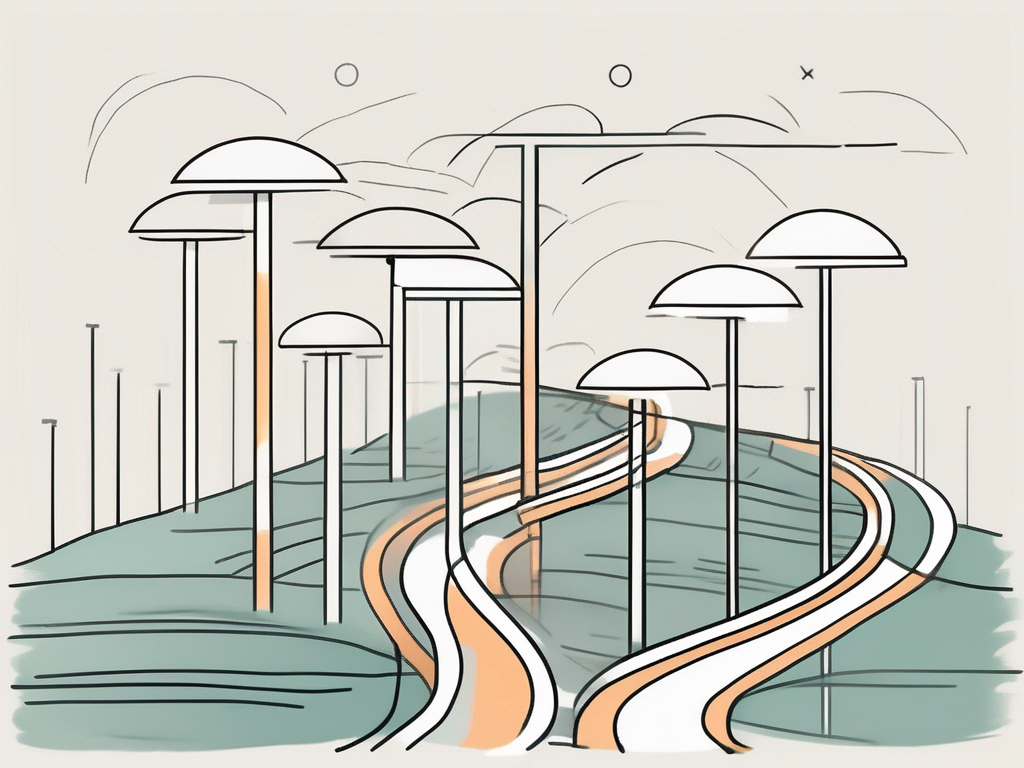Product Roadmap vs Gantt Chart: A Comprehensive Comparison

In project management, there are various tools and techniques available to help professionals effectively plan and execute projects. Among these tools, two popular options are the Product Roadmap and the Gantt Chart. While both serve a similar purpose of visualizing project timelines and tasks, they have distinct features and unique benefits. Understanding the differences and similarities between these tools is crucial for project managers to make informed decisions and choose the right tool for their specific project needs.
{{resources-component-1}}
Understanding the Basics
In today's fast-paced and competitive business environment, having a clear understanding of product development and project management is crucial. Two important tools that aid in this process are the Product Roadmap and the Gantt Chart.
What is a Product Roadmap?
A Product Roadmap is more than just a document; it is a strategic tool that helps guide the development and evolution of a product. It outlines the vision, goals, and direction of the product over a specific timeframe. By providing a high-level overview of the product's features, functionalities, and planned releases, the roadmap ensures that the product team, stakeholders, and other relevant parties are aligned and on the same page regarding the product's development and future trajectory.
Creating a product roadmap involves careful planning and collaboration among various teams and stakeholders. It requires a deep understanding of the market, customer needs, and business goals. The roadmap acts as a roadmap, guiding the product team through the entire product development lifecycle, from ideation to launch and beyond.
One of the key benefits of a product roadmap is that it helps prioritize and communicate the product's strategic initiatives. By clearly defining the product's goals and objectives, the roadmap enables the team to focus on the most critical features and functionalities. It also helps manage expectations and provides a framework for decision-making throughout the product development process.
What is a Gantt Chart?
While a product roadmap provides a strategic overview, a Gantt Chart offers a more granular view of project schedules. A Gantt Chart is a visual representation of project timelines that shows the activities, tasks, and milestones over a specific timeframe.
The Gantt Chart provides a horizontal timeline view, with each task represented as a bar. The length of the bar represents the duration of the task, while the position on the timeline indicates the start and end dates. By visualizing the project's timeline, the Gantt Chart allows project managers to see the project's progress, dependencies, and resource allocation at a glance.
Project managers can use the Gantt Chart to identify potential bottlenecks, allocate resources effectively, and track the project's overall progress. It helps in managing project timelines, ensuring that tasks are completed on time and within budget.
Moreover, the Gantt Chart facilitates effective communication and collaboration among team members. It provides a common visual language that everyone can understand, making it easier to discuss project status, identify dependencies, and plan for future tasks.
With the help of modern project management software, Gantt Charts have become even more powerful and versatile. Project managers can now easily update and modify the chart as the project progresses, making it a dynamic tool that adapts to changing circumstances.
In conclusion, both the Product Roadmap and the Gantt Chart are valuable tools in product development and project management. While the roadmap provides a strategic overview and aligns stakeholders, the Gantt Chart offers a detailed view of project schedules and helps manage tasks effectively. By utilizing these tools in tandem, businesses can ensure successful product launches and project executions, ultimately leading to improved customer satisfaction and business growth.
Key Features and Components
Essential Elements of a Product Roadmap
A Product Roadmap is a strategic document that outlines the vision, goals, and direction for a product. It serves as a communication tool between the product team, stakeholders, and other relevant parties. A well-crafted Product Roadmap typically includes key elements such as:
- Strategic goals and objectives: The Product Roadmap should clearly define the overarching goals and objectives that the product aims to achieve. These goals should align with the overall business strategy and vision.
- Planned releases and timelines: It is important to outline the planned releases and their corresponding timelines. This helps in setting expectations and managing stakeholders' and customers' anticipation for new features and updates.
- Features and functionalities: The Product Roadmap should highlight the key features and functionalities that will be developed and added to the product. This provides a clear understanding of the value proposition and the problem-solving capabilities of the product.
- Dependencies and constraints: Identifying and documenting dependencies and constraints is crucial for successful product development. This includes any external factors, technological limitations, or resource dependencies that may impact the delivery of certain features or functionalities.
- Resource allocation and team roles: The Product Roadmap should outline the allocation of resources and team roles required for the successful execution of the product strategy. This includes identifying the necessary skill sets, assigning responsibilities, and ensuring the availability of resources throughout the development process.
Crucial Components of a Gantt Chart
A Gantt Chart is a visual representation of a project schedule that helps in planning, coordinating, and tracking tasks and their dependencies. It provides a comprehensive overview of the project timeline and progress. A well-designed Gantt Chart generally comprises the following components:
- Tasks and subtasks: The Gantt Chart breaks down the project into individual tasks and subtasks. This allows for a detailed understanding of the work required to complete the project.
- Start and end dates: Each task and subtask is assigned a start date and an end date. This helps in visualizing the project timeline and identifying any potential scheduling conflicts.
- Duration of each task: The Gantt Chart displays the estimated duration of each task. This helps in determining the overall project timeline and identifying critical path tasks that may impact the project's completion date.
- Dependencies between tasks: Dependencies between tasks are represented in the Gantt Chart to illustrate the order in which tasks need to be completed. This allows for effective resource allocation and ensures that tasks are executed in the correct sequence.
- Assigned resources and team members: The Gantt Chart assigns resources and team members to each task. This helps in understanding the workload distribution and facilitates effective communication and collaboration within the project team.
The Purpose and Benefits
The Role of a Product Roadmap in Project Management
A Product Roadmap plays a vital role in project management by:
- Providing a clear vision and direction for product development
- Aligning stakeholders and team members towards common goals
- Guiding decision-making and prioritization of features
- Enabling effective communication and collaboration
- Serving as a roadmap for resource planning and budgeting
The Advantages of Using a Gantt Chart
Utilizing a Gantt Chart offers several advantages, including:
- Visualizing project timelines and identifying critical path activities
- Managing dependencies and ensuring tasks are completed in the correct order
- Facilitating resource allocation and workload management
- Monitoring project progress and identifying potential bottlenecks
- Improving project communication and stakeholder engagement
Differences and Similarities
How Product Roadmaps and Gantt Charts Differ
Product Roadmaps and Gantt Charts differ in several ways:
- A Product Roadmap focuses on the strategic direction of a product, while a Gantt Chart details the tasks and activities required to complete a project.
- Product Roadmaps are typically more high-level and flexible, while Gantt Charts provide a more granular view of project timelines.
- Product Roadmaps primarily serve as communication and planning tools, whereas Gantt Charts play a role in project execution and monitoring.
Common Ground Between Product Roadmaps and Gantt Charts
Despite their differences, Product Roadmaps and Gantt Charts also share some commonalities:
- Both tools help in visualizing project timelines and dependencies.
- They assist in resource allocation and workload management.
- Both facilitate communication and collaboration among team members.
- They aid in project planning and decision-making.
Choosing the Right Tool for Your Project
When to Use a Product Roadmap
A Product Roadmap is ideal in the following situations:
- When you need to communicate the strategic direction of a product.
- When you want to align stakeholders around product goals and releases.
- When you need to prioritize features and plan releases.
- When you want to guide decision-making and resource allocation.
When to Opt for a Gantt Chart
A Gantt Chart is suitable for the following scenarios:
- When you need to visualize project timelines and dependencies.
- When you want to manage tasks, resources, and timelines in detail.
- When you need to monitor project progress and identify bottlenecks.
- When you want to facilitate communication and collaboration among team members.
Conclusion
In conclusion, both Product Roadmaps and Gantt Charts are valuable project management tools that serve distinct purposes. While Product Roadmaps focus on the strategic direction of a product, Gantt Charts provide a detailed view of project tasks and timelines. Understanding the differences and similarities between these tools is essential for project managers to effectively plan, execute, and communicate project requirements and progress. By evaluating the specific needs of your project, you can choose the appropriate tool that will contribute to its success.




